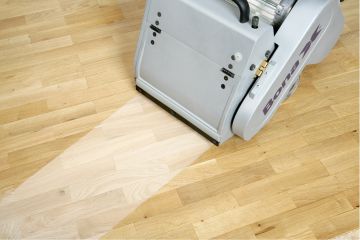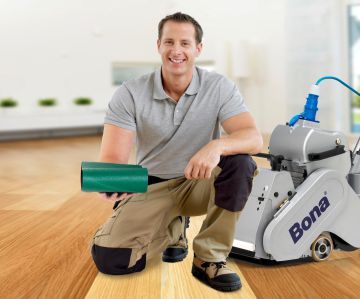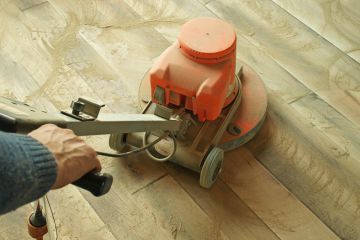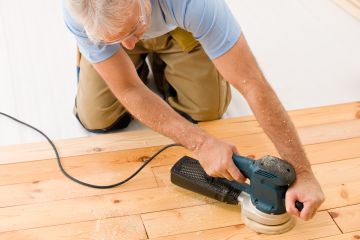Back to Floor Sanding
Top Five Things to Know Before Wood Floor Refinishing
 Why is wood floor sanding so crucial in the lifecycle of every hardwood or engineered wood floor? This is a common question we get as wood floor experts, and the answer is pretty simple, but it includes a lot of aspects specific to the nature of real wood flooring. Wood floor sanding is beneficial to all characteristics of real wood flooring – it improves the appearance of the floor’s surface, and it also improves the floor’s condition by ensuring extra protection and minimising the risk of small issues and imperfections growing bigger and causing serious damage. However, it is not necessary to choose wood floor sanding just because your floor looks worn and damaged, although sanding helps so much in such cases. Wood floor sanding is also a necessity for newly installed floors that are unfinished. Wood floor sanding can also happen just because you want to refresh and change the look of your floor, change the finish and apply fresh new coats of new colour, level of sheen, etc.
Why is wood floor sanding so crucial in the lifecycle of every hardwood or engineered wood floor? This is a common question we get as wood floor experts, and the answer is pretty simple, but it includes a lot of aspects specific to the nature of real wood flooring. Wood floor sanding is beneficial to all characteristics of real wood flooring – it improves the appearance of the floor’s surface, and it also improves the floor’s condition by ensuring extra protection and minimising the risk of small issues and imperfections growing bigger and causing serious damage. However, it is not necessary to choose wood floor sanding just because your floor looks worn and damaged, although sanding helps so much in such cases. Wood floor sanding is also a necessity for newly installed floors that are unfinished. Wood floor sanding can also happen just because you want to refresh and change the look of your floor, change the finish and apply fresh new coats of new colour, level of sheen, etc.
There are so many reasons why you would opt for wood floor sanding, and one thing about wood floor sanding remains constant – it makes your floor feel like a renewable source, which means you can enjoy a wooden floor that looks and feels like brand-new over and over again throughout the years. Depending on the type and thickness of the wooden floor, it can be sanded up to six times in its lifespan. In addition, wood floor sanding is an essential part of the floor maintenance routine, and it is crucial if you want to enjoy your investment for many decades. However, before you start a wood floor sanding project and hire professionals, here are the top five important wood floor sanding basics you want to learn more about.
Can I Skip Grits During Sanding?
When it comes to wood floor sanding, there is a sequence of varying sandpaper grits. The variety of sanding grits is used for a smooth and progressive abrasion of the surface of the floor that ensures the best results and the smooth, even, and uniform effect you are going for. All grits are important for achieving the desired result and for ensuring the finishing product will ensure an even and uniform coverage. If you decide to skip more than one grit in the sanding sequence, you will most probably end up with deep scratches left into the wood and or simply a grit that is too fine and not effective enough to remove all imperfections and issues on the surface of the floor. However, be aware that you are recommended to use all the grits recommended by flooring professionals and don’t skip even one.
What Grit to Start with?
 There are not even two wooden floors that are identical. Every wood floor has its specifics and requires a specific approach, plus every wooden floor is exposed to a different amount of wear and tear and can be damaged to a different extent. Therefore, there is no one straightforward answer to what grit to start the wood floor sanding project with. It depends on the project.
There are not even two wooden floors that are identical. Every wood floor has its specifics and requires a specific approach, plus every wooden floor is exposed to a different amount of wear and tear and can be damaged to a different extent. Therefore, there is no one straightforward answer to what grit to start the wood floor sanding project with. It depends on the project.
Be sure to always discuss the condition of the floor and the upcoming sanding project with the sanding professionals and have them inspect the floor before the start of the project. This is the best way to determine the exact grit the sanding project should start with. However, in general, with newly installed and little-used floors, there is one main rule that often works: choose the finest grit you want to finish with, then work back to the coarser grit by skipping one grade between each round of sanding.
What Grit to End with?
Your choice of grit to end the sanding project with will most probably determine how the floor is going to look in the end and what the result will be. Since all wood floors are different, there is also not even one general rule that can be applied to all of them for the end grit you would choose to finish the project. However, generally, wood floor sanding specialists will rarely if not never, use a grit finer than 120 and a bit coarser grits 100 and 80 are also commonly used for finishing up an average domestic wooden floor. Remember, too fine of grit than what the floor requires can close the grit, and the finishing product won’t adhere effectively.
Use a Big Sanding Machine or an Edger First?
 Whether to use the heavy-duty wood floor sanding machine or opt for the wood floor sanding edger highly depends on the level of experience of the person who is going to work with the tools. In most cases, beginners and first-time sanding DIYers are recommended to use the big sanding machine before the edger.
Whether to use the heavy-duty wood floor sanding machine or opt for the wood floor sanding edger highly depends on the level of experience of the person who is going to work with the tools. In most cases, beginners and first-time sanding DIYers are recommended to use the big sanding machine before the edger.
Since beginners often tend not to have a smooth transition cut at the wall, it will be better to finish the more heavy-duty job first and then continue with the edger to remove all mistakes and smooth out the entire surface of the floor. Edging will ensure you will be able to have all drum marks, uneven distances between the walls and the sanded area smoothed out, and the floor will look finished and sleek after the more detailed job with the edger.
Where to Start with the Sanding Machine?
 You are maybe wondering if you should start left to right or right to left with the big sanding machine. The truth is that the direction is mainly determined by the type of sanding machine. In case you are using the older type of drum sander, you should start working your way out from right to left. However, if you are using a belt sander for the project, you should go in the opposite direction as recommended by the machine manufacturers and sanding experts.
You are maybe wondering if you should start left to right or right to left with the big sanding machine. The truth is that the direction is mainly determined by the type of sanding machine. In case you are using the older type of drum sander, you should start working your way out from right to left. However, if you are using a belt sander for the project, you should go in the opposite direction as recommended by the machine manufacturers and sanding experts.
The difference comes from the different locations of the carriage wheel of the two types of sanding machines. The carriage wheel of a drum sanding machine is located directly behind the drum, while the carriage wheel of a belt sander can be found left of the drum. When sanding, the carriage wheel should follow in an area that has already been sanded to prevent sanding irregularities.